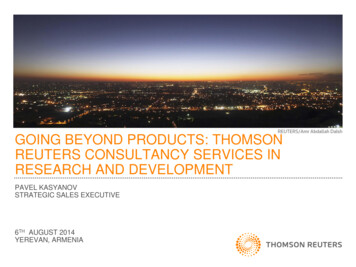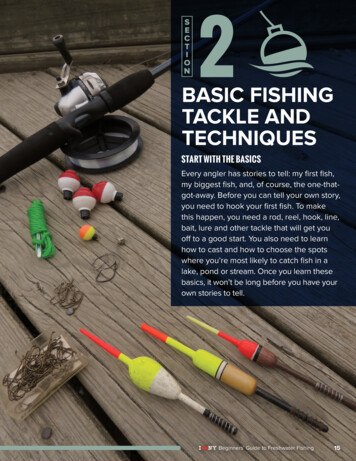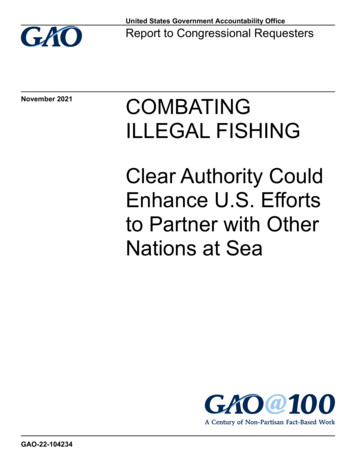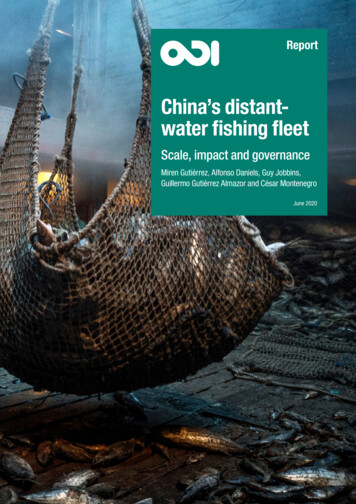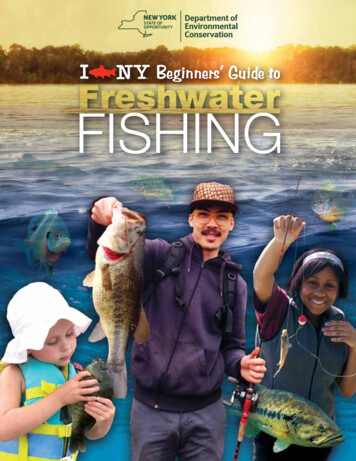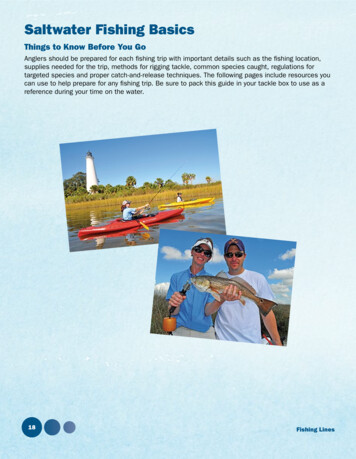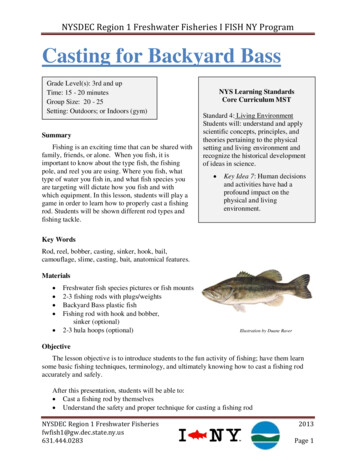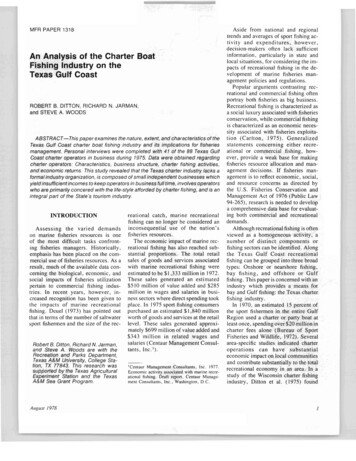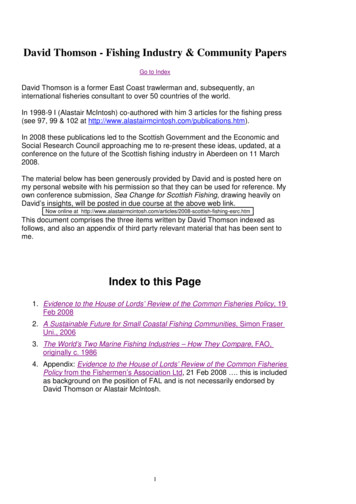
Transcription
David Thomson - Fishing Industry & Community PapersGo to IndexDavid Thomson is a former East Coast trawlerman and, subsequently, aninternational fisheries consultant to over 50 countries of the world.In 1998-9 I (Alastair McIntosh) co-authored with him 3 articles for the fishing press(see 97, 99 & 102 at In 2008 these publications led to the Scottish Government and the Economic andSocial Research Council approaching me to re-present these ideas, updated, at aconference on the future of the Scottish fishing industry in Aberdeen on 11 March2008.The material below has been generously provided by David and is posted here onmy personal website with his permission so that they can be used for reference. Myown conference submission, Sea Change for Scottish Fishing, drawing heavily onDavid’s insights, will be posted in due course at the above web link.Now online at tish-fishing-esrc.htmThis document comprises the three items written by David Thomson indexed asfollows, and also an appendix of third party relevant material that has been sent tome.Index to this Page1. Evidence to the House of Lords’ Review of the Common Fisheries Policy, 19Feb 20082. A Sustainable Future for Small Coastal Fishing Communities, Simon FraserUni., 20063. The World’s Two Marine Fishing Industries – How They Compare, FAO,originally c. 19864. Appendix: Evidence to the House of Lords’ Review of the Common FisheriesPolicy from the Fishermen’s Association Ltd, 21 Feb 2008 . this is includedas background on the position of FAL and is not necessarily endorsed byDavid Thomson or Alastair McIntosh.1
Go to IndexCALL FOR EVIDENCEReview of the Common Fisheries PolicySubmission by David Thomson, 19 February 2008To: Julia LabetaClerk to the EU Env & Agr Sub-CommHouse of LordsLondon SW1A 0PWe-mailcopy to : Alistair DillonCommittee SpecialistHouse of .ukSubmitted by: David ThomsonInternational Fisheries Management Specialist(currently with the UN / FAO in Indo-China)UK residence : W. Covesea Farm, Duffus, Morayshire, IV30 5QXOverseas telephone : 00855 (0)92 620 981E-mail address :wcovesea3@yahoo.comBrief bio-data – David Thomson : former Assistant Professor, University of Rhode Island, USA;former Lecturer, College of Fisheries, Canada; former Fisheries Industry Officer, FAO Rome, Italy;former consultant to the World Bank, the EU, UNIDO, ADB, and to bilateral aid programmes of theUSA, UK, Japan, Germany, Iceland, Italy; former fisherman and skipper, UK and Ireland. Visitinglecturer / conference speaker, Edinburgh University, Oregon State University; Stirling University;Marine Laboratory Aberdeen, Simon Fraser University Canada, University Pertanian Malaysia,SEAFDEC Bangkok, Kanagawa International Fishery Centre,Tokyo, Latin America FisheriesSymposium, Cancun, Mexico; etc.Author or joint author of : An Assessment of Marine Fishery Management Regimes (UK); GlobalPatterns of Fish Industry Development (UNIDO); Scientific and Intuitive Fishing (USA); A SustainableFuture for Small Coastal Fishing Communities (Canada); Commercial Fishes Biology (FAO); FishProduction and Markets (Ireland); Fisheries Manpower Planning (FAO); Fishing Grounds and FishingCharts (FAO); A Fisherman’s Reflections on a Beautiful but Troubled World (Canada); The SeaClearances (UK); Coastal Fisheries Management (UK);The Seine Net (UK); Pair Trawling and Pair Seining (UK); Global Creels Study (UK); StrategicPlanning Manual (UNIDO); Fishing Vessel Design (Norway); Intermediate Technology and AlternativeEnergy Systems for Fisheries (FAO); etc.2
Evidence SubmittedConservation and Management1.To what extent have the CFP management measures, and recovery plans been effective inensuring conservation and sustainability ?A review of the past 30 years, or just of the period in question since 2002, reveal that the impact of CFPmanagement on UK fisheries has been almost entirely negative. Whether we look at annual stockassessments, continuing fleet decline, or the stagnation of the economies of the coastal fishing towns andvillages, there is almost no sign of recovery. Neither the fish stock, nor the harvesting fleets and shoreindustries, have been sustained. The decline in fish industry benefits has been especially hard on the moreremote and island coastal communities. These traditional fishing villages have no comparable resource onwhich to base a sustainable economy. Continuing calls for further quota cuts and additional fleet reduction, areample evidence that the whole policy and its related measures are failing, year after year.2. What are your views on : total allowable catches; effort limitation; marine conservation areas;rights-based management; and technical conservation measures.Total allowable catches are based on the scientists’ best estimates of stock size, plus the judgment of fisheryadministrators, and also the lobbying of national governments for a greater share for their respective fleets.The end result rarely satisfies any party. It should also be noted that the estimates are based on 2 year-olddata, and in some cases onbogus statistics, as for example from the years of false reporting of monkfish east and west of the 4 degree line,- the result of scientists and administrator’s failure to recognize a reality that reflected badly on theirmanagement. The colossal amount of discards – up to 600,000 tonnes a year, was never calculatedaccurately, by volume or species, and so not included in the estimates of production. Other governments andfishery regimes take a more flexible attitude to stock assessment, and consider estimates provided by fishersand independent observers of the marine environment. UK researchers have often complained in privateabout the political pressures under which their estimates are made.Effort limitation is a much more reliable tool than TACs or quotas for managing the operations of theharvesting fleets. The Faeroe Isles for example has abandoned fishery management by quotas in favour ofeffort limitation, which can be achieved by limiting the number and power of vessels, the gear they may use,the seasons when they may fish, and where appropriate, the number of days they may spend at sea.Marine conservation areas are good in principle, but suffer from hijacking by interested groups, each withtheir own agenda, and often motivated more by a desire for power or influence. Green and wildlife NGOsknow that their involvement in and potential control of, conservation areas, will add to their public profile andincrease the opportunities to draw income from the general public and from government. Some of them haveno interest in the welfare of fisher-dependent communities, and a few have indicated their wish to put an end tomost forms of commercial fishing. The tension between fishing communities and groups promoting MCAs isa global phenomena. Members of the Indigenous People’s Forum on Bio-Diversity from South Africa, India,Latin America and Pacific states, and supporting NGOs from UK, USA and Europe, walked out of the CBDmeeting in Rome Italy on 14 February 2008, protesting that they were marginalized and silenced by theCommission despite the importance of the recommendations to their lives, lands and waters, and the criticalimpact of protected areas on their rights.MCAs work best when there is meaningful involvement by the communities affected who should have a rightto veto extreme measures that would destroy their livelihoods. A few countries like Japan and the USA havedeveloped useful examples of MCAs or similar reserves designed to both protect resources and sustain localeconomies. They give substantial fishery management authority to their coastal cooperatives. Fishermen onScotland’s west coast fear that the proposed Marine Park, if imposed on their area would simply allow thealready bloated seal population to expand at the expense of the local fleet. The seals there currently consume4 times as much fish as are caught by the local west coast and islands fishing vessels.There are three fundamental principles that WWF and IUCN seek to apply abroad with considerable diligencewhen considering possible marine parks or sanctuaries. These principles are : 1. there must be soundscientific evidence of the need for such a measure, and also reliable indications that the measure will have the3
desired result; 2. there must be full and open consultation with the local fishers and their communities, whoseagreement must be obtained before proceeding with the venture; 3. if some fishers or stakeholders are to loseincome as a result of the intervention, then there must be adequate compensation or alternative employmentprovided. The UK would do well to apply these principles firmly to every Marine Park or MCA proposal.Rights-based management is being developed in many of the world’s fisheries, and can be an excellent toolto ensure some justice and equity in the allocation of resources or in ensuring continuing access for vulnerablegroups. The main danger facing the UK from EC / CFP interpretation of rights-based management, lies in theassumption by some that these very rights might be bought and sold on an open market. Once that ispermitted the system ceases to be rights-based and becomes market-based, with fishery sector jobs andcommunity’s economic futures being traded like any other commodity. That is exactly what will happen ifITQ arrangements are developed to their ultimate end. Several governments have allocated rights-basedaccess to fish resources, in perpetuity, to indigenous groups that would be vulnerable if their rights were to bemade a marketable entity. So community quotas and other special arrangements have been organized in theUSA for native Americans, and in New Zealand for Maori peoples. Canada’s Fishery Minister recently liftedthe ban on cod fishing for inshore fishers using open boats, to ensure these persons and their out-ports, have amodest livelihood throughout the year.Technical conservation measures can be good or unhelpful. Most of them have some side-effects that areunfortunate. They are most difficult to apply in mixed species fisheries such as the UK demersal or whitefish sector where the size of a legitimate target fish can vary so much. The mesh size suitable for maturewhiting is smaller than that for haddock, which is smaller than that for cod, and so on. But if your boat’squota allocation includes all three species, what do you do ? Fishery administrators then introduce moremeasures to address the side effects, such as enforced discarding, but the end result is an unsatisfactory mix ofconflicting regulations that only frustrate the fishermen while doing nothing for stock conservation. It shouldalso be borne in mind that most skilled fishers can get around technical measures. The answer must be tohave the industry fully involved in all the decisions taken and to avoid any technical measure that does nothave general support from the harvesters themselves.3.To what extent has current management increased discard and by-catch ?How could these problems be tackled ?I have seen no evidence that measures since 2002 have increased the amounts of discards or by-catch, butcertainly the past 3 decades, the illogical fixation on single species quotas in a mixed species fishery, has beenthe key element that has resulted in the enforced discarding of over half a million tonnes of good fish eachyear, in the North Sea. By any measure of fishery management assessment, this has been a travesty for the fishstock, the markets, and the fishers, and has probably caused more damage to the resource than any degree ofexcess fishing pressure.How can this problem be tackled ? First and most importantly, by scrapping the whole concept of singlespecies quotas for the demersal and mixed fish / prawn fleets. Do what many wise fishery administrationshave done from Namibia to the Faeroe Isles, and instruct the fishers to land everything they catch. Second,ban discarding completely.Namibia, which unlike Faeroes, still has a basic quota system, uses an arrangement of levies to limit targetingof non-quota species. All fish caught must be landed. On-board inspectors monitor and police that. Anyfish landed excess to quota or not included in the quota, are sold. The proceeds are returned to the vessel, minus a levy. The levy is finely balanced to achieve two purposes : one is that the fishers do not lose moneyby keeping, storing, and landing the fish; and the other is that they make no profit on that part of the catch.Each year when total landings are assessed and compared with the previously set TACs or species quotas inNamibia, there is little disparity, and so the system has been seen to work well.4.Do fishery policies need to adapt to climate change ?None of us know yet how climate change will affect our fisheries. It would be foolish and presumptuous toadapt fishery management policies before we know what changes are definitely taking place in the marineenvironment. There are indications that some species are migrating northwards. We see some sub-tropicalspecies in our southern waters, while cold water fish like cod appear to moving north from their formergrounds.4
Control and Enforcement5.To what extent has the CFCA assisted in improving matters ? What are the efficacy ofsystems in place ?The CFCA systems are too often self-defeating and alienating the fishers. Too many rules and penaltiesappear to the stakeholders to be perverse and illogical. Ill-conceived laws and regulations bring the wholelaw into disrepute. Many fishery officers have expressed their disgust and resentment to me, at having topunish fishers for failing to follow measures that are of no benefit to the resource. The CFP has failed to givethe fishery stakeholders a meaningful say in the regulations drafted. International meetings have noted thatillegal fishing and landings, wasteful discarding, rules beating, and misreporting can to some degree be a directresult of badly-conceived management rules. Some such rules may be the product of flawed science, others ofpolitical or factional preferences, and still more of disregard of advice or ignorance of fishing technology.Many skippers and observers maintain that the system has made criminals out of otherwise honest men.6.What is your view of different penalties for serious infringements in EU StatesDifficult to control given the intransigence and resistance by France, Spain, etcStructural policy7.To what extent have Member States adjusted their fleets to balance capacity with opportunity ?Low-impact small scale fleets have shrunk while powerful high capacity units have mostly increased in fishingpower if not in number. This has been an indirect result of the CFP measures which have failed to protect thesmall scale fleets which have minimal impact on the resource, and have few negative effects on the marineenvironment.UK has the most productive EEZ of any of the EU members, yet its fishing fleet has lost more vessels than anyother state, - all in conformity to EC demands to decommission more and more boats. What is left of ourfleet is faced with many more restrictions than their predecessors, - so instead of “opportunity”, UK fishers arefaced with a massive constraint on their operations.8.What is your experience of the new fisheries structural fund, EFF ?No comment9. What are your views on the possible impact of WTO-level discussions as regards subsidies inthe fishing sector ?Subsidies in the fishing sector are an emotive issue which is often subject to claims that have little factualbasis. While agriculture is heavily subsidized in Europe, fisheries are not (and should not) be subsidized.But we see a growing number of programmes and quangos established, each with a claim to manage part of theindustry, and all wanting to be paid for by the industry, since their services are “a subsidy” !Far better tohave our fishing industry manage and finance these services, - and select which ones they really need. Whyshould government undertake advertising on behalf of the fish merchants and processors ?That is anexample of something the industry can do itself. Fish product development and fishing gear development arealso things the industry can do quite well.The main work on global fisheries subsidies and fleet over-capacity, was written by Dr Francis Christie, forFAO and the World Bank. He was aware that his papers did not address the situation of the smaller scaleinshore and coastal fishing fleets of the world, so he asked Dr John Kurien to investigate the subject further.Prof. Kurien’s paper, which can be found on the internet, concluded that the most heavily subsidized fishingfleets were the large scale industrial fishing units. Apart from a modest fuel subsidy in some countries, mostsmall scale fleets operate with little financial aid from their governments. Many fear that the WTO will takea sledgehammer to crack a peanut, and may fail to discriminate between the different fishing fleets, each ofwhich has its own particular raft of taxes, facilities, and technical support programmes.WTOrecommendations may also favour the large scale, high-impact commercial fleets over the small scale coastalsector.5
Ref : Kurien, John; 2006, Untangling Subsidies, Supporting Fisheries: The WTO Fisheries Subsidies Debate,ICSF.DR F. Christy’s calculations which are the basis of much of the WTO position can be found inAppendices 2, 3, 4, and 5 of the FAO State of Food and Agriculture 1992 report, Rome 1993.A shortersummary of Kurien’s paper, Over-capacity, Over-fishing and Subsidies, is available from the U.S.A secretariatin NMFS of the Pacific Fisheries Forum. The shorter version was presented at the 2006 Forum in Hanoi.One should also take a hard look at EC fishery subsidies which are continuing and which mostly benefit Spainand France, and which have often been used to support EC fleets in their operations off West Africa andelsewhere, - usually with tragic results for the local fish stock and fishing communities. Senegal is a countrywhose fishing grounds and fish stocks are of great interest to European fleets. But their intervention there,while agreed to by Senegalese Ministers, and assisted by the EU, has seriously hurt the local fishing fleets andreduced some stocks to a level of concern.Governance10.What is your view on the future evolution of Regional Advisory Councils ?No comment11.How do you consider EU fisheries should ideally be governed ?How appropriate and feasible do you consider a regional model to be ?EU Fisheries governance :Is a regional model appropriate ?It could be, but only within strict limitations. Fisheries governance above all should be transparent, based onclearly stated objectives, and be participative, involving fully the fishing communities and the fishing industrystakeholders.Too often, consultations have been empty PR gestures with no genuine attempt to listen tothose affected. (The writer has seen fishermen’s leaders publicly insulted by government representatives atsupposed consultation meetings). Fisheries governance should also be open to review and critique bycompetent, independent bodies.There are a number of international examples. These include the SADC and ASEAN countries which haveagreed regional fishery management policies. The USA has similar arrangements with Canada, Mexico, andthe small states of the Caribbean and the Pacific. None of these countries have yielded their EEZs to anycentral management like the EU CFP. There are also the 3 main regional Tuna Commissions of the Indian,Pacific, and Atlantic Oceans, plus 2 in the Americas. (see www.tuna-org.org ).In each of those cases, the participating governments retain full control over their 200 mile EEZs and their ownfleets and their national fishery management systems. But they meet annually to agree on commonapproaches to the management of shared stocks. That works very well, guaranteeing cooperativemanagement but preserving sovereign rights.In contrast the EC / EU, under the Lisbon treaty will have unlimited control over all "marine biologicalresources" (the part referring to joint EU/national control of fishing does not reflect the reality). Marinebiological resources extend by definition from whales and basking sharks to the last frond of seaweed. Thiscontrol, to be exercised from the desk of the Fisheries Commissioner in Brussels, will extend from the Balticthrough the north-eastern Atlantic, North Sea, Mediterranean, Aegean and Adriatic seas to the Black Sea. Ittakes little account of the vast differences in regional fish species, different fishing methods,local consumption patterns, local fisheries culture and local social and employment structures. That kind ofcentrally-controlled regional model is a recipe for inflexible and undemocratic management from a distancethat is insensitive to local needs and local situations requiring tailored responses to particular issues.The best fishery management system by far is one that is locally based and which the local stakeholders largelyoperate themselves with government taking only a supervisory role and providing the overall policy. Someexamples can be found in the USA and Japan, where specific fisheries form their own rules and enforce theirown members. The UN Agencies and several bilateral organizations and NGOs assist a number of developingcountries to adopt this model.In no part of the world that I know, has any group of fishing states consideredor adopted a centrist EU type model that requires them to give up their sovereign rights over their nationalfisheries.David B Thomson19 February 2008Go to Index6
Go to IndexA Sustainable Future for Small Coastal Fishing CommunitiesPaper presented at A.R. Scammell Academy, Change Islands, Newfoundlandat the Change Islands / Simon Fraser University workshop conferenceOceans and the Future of Endangered Coastal CommunitiesAugust 8 – 102006byDavid B Thomsoninternational fisheries and coastal consultante-mail contactwcovesea3@yahoo.comContents :Coastal Communities;global threats to their futuretheir value and importancenational and international effortsSustainability Issues;resource sustainabilityeconomic sustainabilitysocial sustainabilityConclusionsPrecis :The United Nations Food and Agriculture Organisation has estimated that small scalecoastal fisheries support the livelihoods of over 200 million persons worldwide. Most of this fisherdependent population lives in small villages scattered along the coast of the world’s continents andislands. The bulk of them are found in South Asia and South-East Asia.A significant number arelocated around the shores of North and South America and Europe. Practically all thesecommunities are under threat from globalisation, centralisation, and from the growing demand foraccess to fishery resources and coastal lands. But these small villages are of enormous national,cultural, economic, and social importance. They have a strategic value in their presence andprotecting influence over the coast and coastal assets. Their loss would impact on their countriesfor generations to come, and if allowed to die, their restoration could require huge investments ineffort and capital. This paper examines the issues related to a sustainable future for small coastalcommunities, with particular reference to the Change Islands, and argues that wise administrationand modest support could ensure they become or remain viable and continue to be a valued asset totheir province or nation.Coastal Communitiesglobal threats to their futureththThe agricultural revolution of the 18 century and the industrial revolution of the 19 century resultedin a huge shift of population from rural to urban areas as mechanisation made it possible to replacefarm labour with machines. This naturally had a huge impact on rural villages, most of whichdeclined in size and significance.Some communities were brutally affected when mechanisation7
thand amalgamation had dreadful unforeseen results in the 20 century; - in the dustbowl of America’swheatlands, and the collectivisation of previously viable private farms in the Soviet Union. Theprocess of urbanisation hit the industrialised countries first, but is now continuing apace in Africa,Asia and Latin America. Some see the trend as irreversible and to be accepted. Others believethat priceless elements of our culture, our links to nature, social cohesion, and even nationalsecurity, may be lost unnecessarily by our failure to protect what is beneficial and important in ourblanket acceptance of all that technology and markets have to offer.Fishing communities have suffered less from urbanisation and mechanisation, but are now facedwith serious threats to their very existence from market forces and legal measures that weight thedice against them. The specific form these threats take varies from country to country. We shallconsider them as they affect Newfoundland, North America, Scandinavia, Europe and south andsouth-east Asia, to provide us with a global background to the issue.Other looming threats are more environmental in nature. Fish stocks are under greater pressurethan ever before. Global warming may result in sea level rises that could endanger some coastalareas. Deforestation and industrial pollution are contributing to the number of factors that coulddestroy the coastal zone environment in the long term. Other parts of the world have witnessedextensive damage and loss of life from sudden tsunami waves created by seabed earthquakes, thatmay have occurred hundreds of miles away. Tropical storms and hurricanes appear to be on theincrease, as seen recently in the Gulf of Mexico.their value and importanceCoastal villages have a value that can not be assessed in monetary terms alone. They are anational asset for tourism, for rural sustainability, and for strategic issues like security of our shoresand remote locations. When I was discussing these issues 38 years ago with New Englandfishermen and academics, fisher leader Jake Dykstra defended the continuance of small harboursand landing places from a wider economic perspective. He said that tourists have no wish to seedead or stagnant villages. They want to see a few boats, some fishers mending their gear, andstalls where they can buy fish and lobster, fresher than any they see in the city. These communitiesalso have a cultural and historical significance. Nowhere is that more true than in Newfoundland.The Province’s wealth of traditional songs, jig tunes and sea shanties, was born and nurtured inhundreds of small outports and bays that made up for their lack of urban sophistication by theirenormous poetic and musical talents which expressed the heart and soul of Newfoundland, itstraditions and its values.The fisher communities and the small scale fisheries in general, are based on a way of life ratherthan on economic opportunity. Newfoundland knows well from bitter experience how somecompanies and corporations have a ‘get-rich-quick’ mentality that grabs resources and concessionsin the initial period, but abandons the community once these benefits start to decline. In contrast,small fishers and their communities are in their business for the long haul. They have generationalroots in their way of life and these are valued more than temporary affluence. This is at variancewith modern economic development theory that worships the power of the market place. But itprovides a stability that is absent from most profit-motivated enterprises.national and international efforts to protect and nurture coastal communitiesWhile some who have boundless faith in market forces and technological progress opine that smallscale businesses and rural villages should be allowed to “wither on the vine”, most governmentsrecognise their importance and try to afford them some long term protection. Interestingly, this ishappening in both the industrialised and developing parts of the world. America has provided“community quotas” to ensure that aboriginal communities will have legal ownership of and access totheir local fish stocks. Japan developed an intricate and sophisticated series of fishery cooperativesthat are empowered to manage local fisheries and to decide on their particular direction ofdevelopment. Indonesia could harvest its huge 3.5 million ton fish production with powerful vesselsand agro-business fish farms, but it has chosen instead to protect its 3.0 million small scale fishersand fish farmers because their continued employment is critical to social stability. When the effectof the EU Common Fisheries Policy, and ICES advice on quotas and fleet sizes, threatened to closemany small coastal ports, Norway made a significant policy decision to maintain its coastal8
communities regardless of cost. Being in the EEA, but outside of the EU, though respecting ICESadvice, it was more free to do so, and so today along its NE coast and the Lofoten Islands, thosesmall villages remain active and viable. The first requirement then for a sustainable future, ispolitical will on the part of national and provincial authorities.The United Nations Agencies have played a part in the promotion of schemes to protect the resourcebase and enhance the economic opportunities for rural, coastal, and island communities. One ofthe schemes encouraged has been ‘TURFS’, territorial user rights in fisheries, which is designed togive communities continuing legal access to and management authority over, their local fisheryresource. The World Bank and the Asian Development Bank are also committed to assisting ruralcommunities, though this is not always well expressed in their development loans. The writer hasjust completed a coastal project for ADB in central Vietnam where poor coastal communes are beingassisted to ensure their future viability.Sustainability Issuesresource sustainability fresh water,
Submitted by: David Thomson International Fisheries Management Specialist (currently with the UN / FAO in Indo-China) UK residence : W. Covesea Farm, Duffus, Morayshire, IV30 5QX Overseas telephone : 00855 (0)92 620 981 E-mail address : wcovesea3@yahoo.com Brief bio-data - David Thomson : former Assistant Professor, University of Rhode Island .
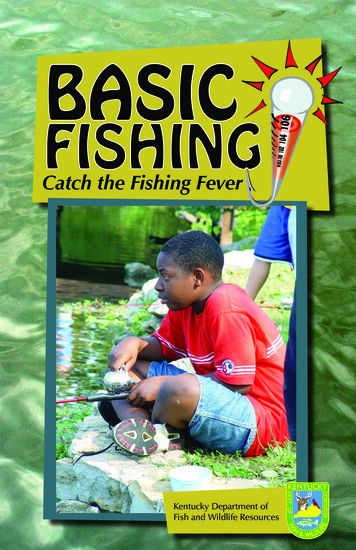
![No, David! (David Books [Shannon]) E Book](/img/65/no-20david-20david-20books-20shannon-20e-20book.jpg)
